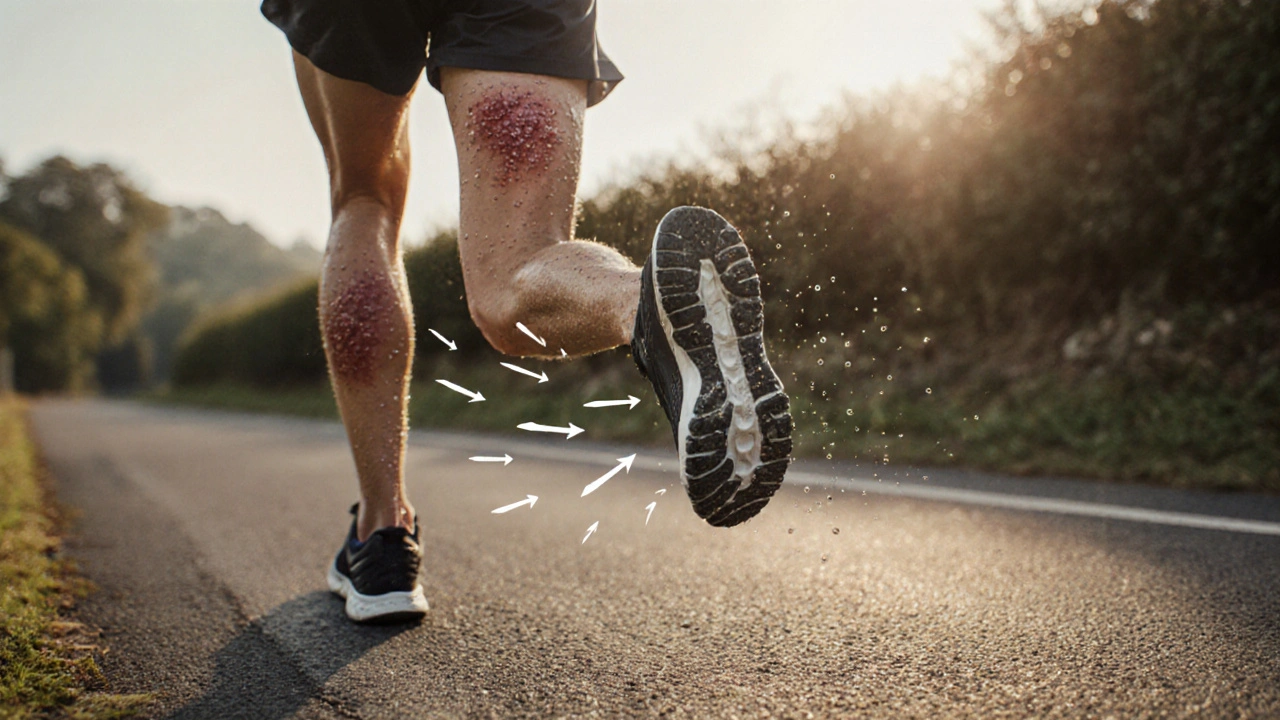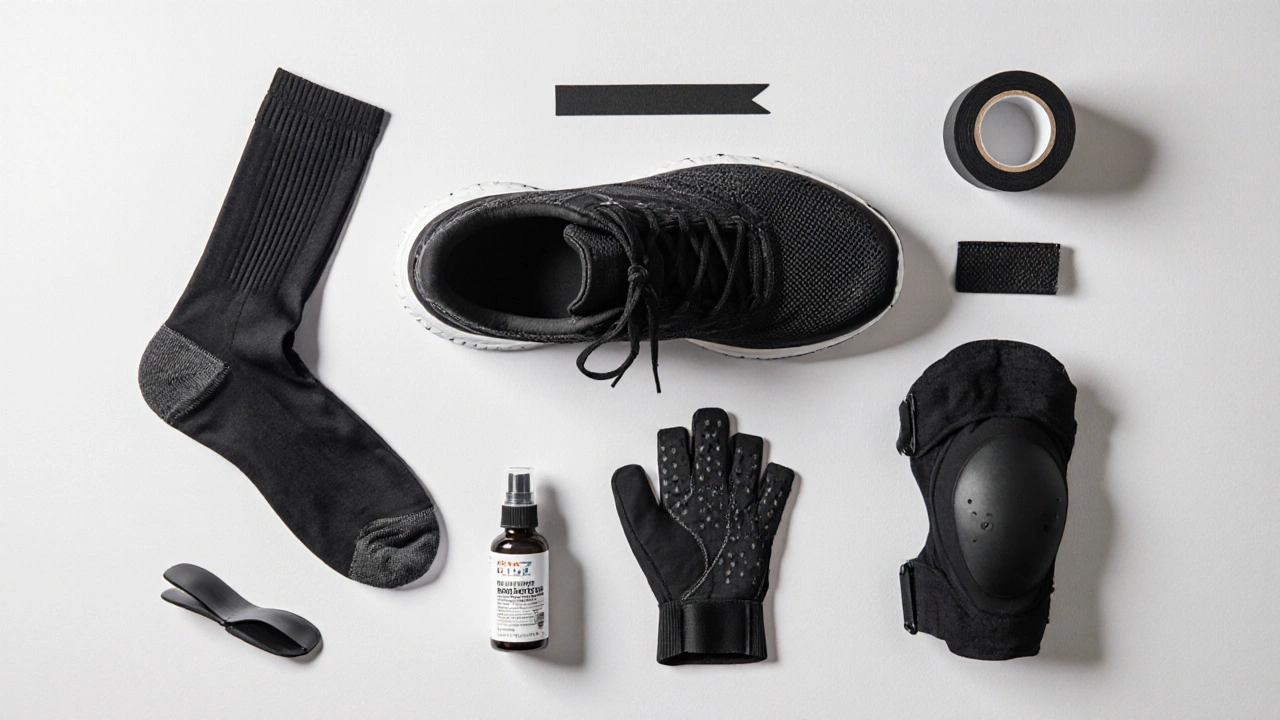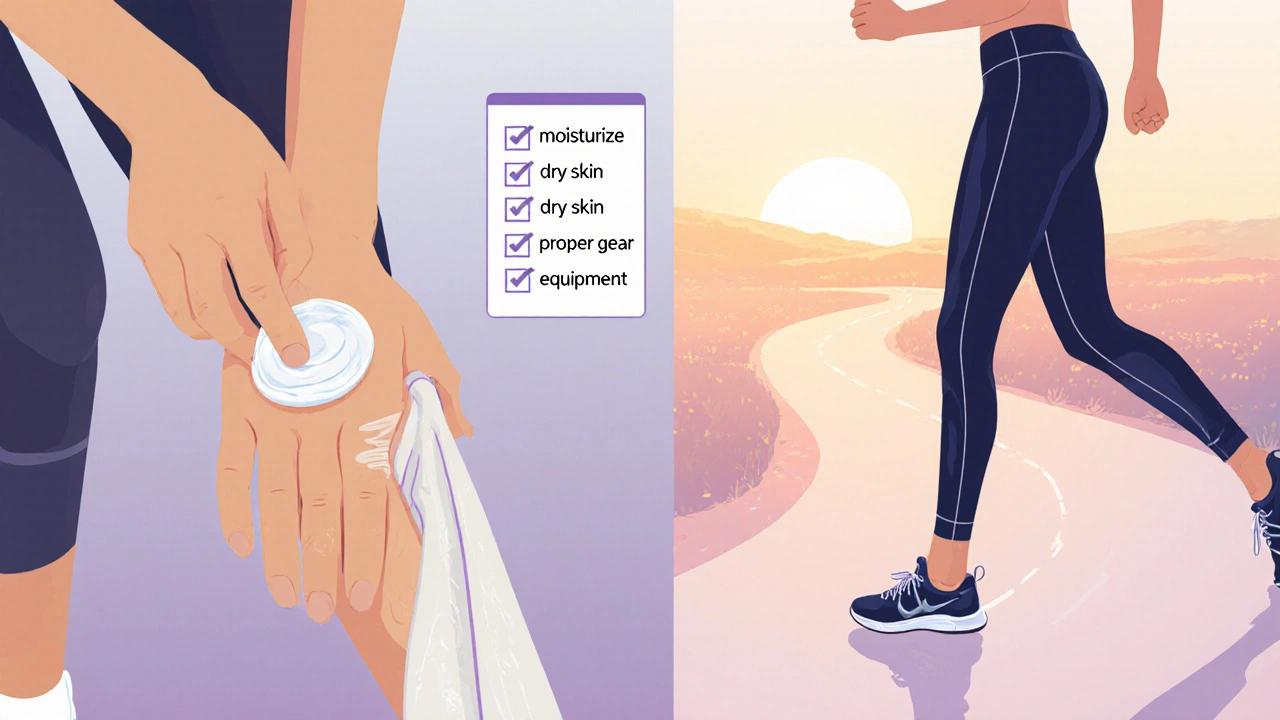Proven Ways to Avoid Abrasions While Exercising
 Oct, 13 2025
Oct, 13 2025
Abrasions Prevention Gear Selector
Prevent Exercise Abrasions
Select your activity to get personalized gear recommendations based on the article's prevention guidelines.
Ever finished a run or a bike ride only to find raw, red patches on your shins, palms, or feet? Those irritating scrapes are abrasions - tiny tears caused by friction, sweat, and the wrong gear. The good news is you can stop them before they start. Below you’ll find a step‑by‑step guide that covers everything from fabric choices to post‑workout skin care, so you can keep moving without the sting.
Understanding Why Abrasions Occur
Abrasion is a superficial injury where the top layer of skin is rubbed off, usually by friction. When you jog, lift, or bike, three forces combine to create that friction:
- Shear stress: The skin slides against clothing, equipment, or the ground.
- Moisture: Sweat softens the outer skin layer, making it more vulnerable.
- Repeated motion: Continuous cycles amplify the tiny pull on skin fibers.
Knowing the culprit helps you target the solution.
Pick the Right Clothing & Footwear
Not all fabrics are created equal. Some trap sweat, some create extra drag.
Technical fabrics are engineered to wick moisture away from the body, keep the skin dry, and reduce friction. Look for materials labeled “polyester‑spandex blend,” “moisture‑wicking,” or “anti‑chafe.”
For footwear, a snug but not tight fit is crucial. Shoes that are too loose cause excess movement, while overly tight shoes increase pressure points.
- Choose shoes with breathable mesh uppers to let sweat evaporate.
- Replace soles when the tread wears down - a smooth sole slides more easily.
- Consider orthotic inserts if you have pronation issues; they align your foot and cut down on rubbing.

Use Protective Gear the Smart Way
When friction can’t be avoided, barriers step in.
Protective gear includes anything that sits between skin and a friction source - think socks, gloves, pads, and tape. Each type serves a specific area.
| Gear | Material | Best For | Pros | Cons |
|---|---|---|---|---|
| Compression Socks | Moisture‑wicking polyester‑spandex | Running, cycling, hiking | Reduces friction, improves circulation | Can feel tight if too small |
| Grip Gloves | Silicone‑coated palm | Weightlifting, rowing | Improves grip, shields palms | May reduce tactile feedback |
| Knee Pads | Foam + neoprene cover | Squats, lunges, contact sports | Absorbs impact, prevents rubbing | Can be bulky for some drills |
| Elbow Guards | Soft gel inserts | Push‑up variations, cross‑fit | Stops skin from rubbing on floor | May shift if not secured |
| Grip Tape | Adhesive polyurethane | Weightlifting bars, bike handlebars | Creates a non‑slip surface | Can wear out quickly with sweat |
Fit each piece snugly so it stays in place; a loose pad slides and creates the very abrasion you’re trying to avoid.
Prepare Your Skin Before and After Workouts
Healthy skin is the first line of defense.
Moisturizer restores the skin’s lipid barrier, making it less prone to tearing. Apply a lightweight, non‑greasy lotion 15‑30 minutes before you dress. Look for ingredients like ceramides, glycerin, or hyaluronic acid.
After exercising, clean the skin gently with a mild cleanser, then pat dry and re‑apply moisturizer. If you notice any hot spots, treat them with an antiseptic spray to prevent infection.
Exfoliate once a week with a soft scrub or a silicone brush. Removing dead skin cells smooths the surface and reduces the friction coefficient.

Adjust Your Environment and Technique
Sometimes the simplest changes save the most skin.
- Stay Dry: Carry a small towel and wipe sweat from high‑friction zones (hands, feet, underarms) during long sessions.
- Modify Routes: If a trail has sharp rocks that constantly scrape shins, switch to a smoother path or wear leggings with reinforced panels.
- Check Equipment: Rough seams on a tank top or a broken zip can become an abrasion source. Replace worn gear promptly.
- Mind Your Form: Over‑pronation in running increases inner‑foot rubbing; a mid‑foot strike may lessen that.
Even small habit tweaks add up to big protection over weeks.
Quick Prevention Checklist
- Choose moisture‑wicking, seamless clothing.
- Wear properly fitted shoes; replace worn soles.
- Apply a thin layer of moisturizer before dressing.
- Use gear that covers high‑friction areas (socks, gloves, pads).
- Keep sweat‑prone spots dry during workouts.
- Inspect clothing and equipment for rough edges before each session.
- Exfoliate weekly; re‑moisturize afterward.
- Adjust technique or route if you notice repeated rubbing.
Follow this list each time you suit up, and the odds of ending a session with a fresh scrape drop dramatically.
Frequently Asked Questions
Can I prevent abrasions without buying special gear?
Yes. Simple steps like wearing seamless, moisture‑wicking fabrics, keeping the skin moisturized, and wiping sweat during long workouts can cut friction dramatically. The key is to eliminate any point where skin rubs against a rough surface.
How often should I replace my running shoes to avoid abrasions?
Most experts recommend swapping out shoes after 300‑500 miles (about 480‑800 km). Once the tread flattens or the upper material starts to wear, the shoe slides more, increasing the risk of skin irritation.
Is it okay to use petroleum‑jelly on my skin before exercising?
Petroleum‑jelly creates a thick barrier that can trap heat and sweat, potentially worsening friction. A lightweight, fast‑absorbing moisturizer is a safer choice for active skin.
What’s the best way to treat an abrasion if I get one?
Rinse the area with clean water, apply an antiseptic spray, and cover with a breathable dressing. Keep the wound moist with a thin layer of antibiotic ointment and change the dressing daily until it heals.
Do compression garments really help prevent chafing?
Because they fit tightly and eliminate seams, compression garments reduce the skin’s movement against clothing, which is a major cause of chafing. Choose pieces with flat seams and moisture‑wicking fibers for the best effect.

Nicole Powell
October 13, 2025 AT 18:05Honestly, if you’re not already using premium moisture‑wicking gear, you’re just asking for bruises.
Ananthu Selvan
October 20, 2025 AT 16:45Wow you think that’s high‑tech? Most people just need to stop sweating so much and maybe wear socks.
Nicole Chabot
October 27, 2025 AT 14:25Great rundown! I love the part about applying a light moisturizer before you suit up – it really makes a difference for my runner’s knees.
Sandra Maurais
November 3, 2025 AT 13:05While your enthusiasm is noted, the article glosses over the importance of proper seam placement – a mis‑aligned seam can be a hidden abrasion hazard. 😊
Gaurav Joshi
November 10, 2025 AT 11:45Honestly, all this gear hype is just a marketing ploy; most abrasions are caused by your own laziness to replace worn shoes.
Jennifer Castaneda
November 17, 2025 AT 10:25There’s a surprisingly complex physiology behind why skin tears happen during exercise. First, repeated shear forces disrupt the stratum corneum, the outermost protective layer. Second, sweat acts as a lubricating agent, reducing friction but also softening the skin, making it more susceptible to tearing. Third, the micro‑topography of fabrics can either amplify or dampen those forces. When you wear a synthetic blend without flat seams, tiny protrusions press against the skin with each stride, creating microscopic abrasions that accumulate into visible rashes.
Furthermore, the body’s inflammatory response can exacerbate the damage, leading to swelling that increases friction in a vicious cycle. Proper pre‑workout skin preparation, such as applying a lightweight humectant, restores the lipid barrier and improves resilience. Post‑exercise care is equally crucial: gentle cleansing, antiseptic sprays, and breathable dressings keep infections at bay.
Finally, equipment choices matter. Out‑of‑shape shoes with worn treads change the gait dynamics, causing irregular pressure points that rub against the foot. Replacing them after 300‑500 miles restores proper foot mechanics and reduces skin shear. In sum, the interplay of moisture, friction, and equipment wear is the triad you must manage to keep abrasions at bay.
Annie Eun
November 24, 2025 AT 09:05That thorough explanation really ties the science to the practical tips you listed earlier. It’s impressive how many variables we overlook when we just focus on the workout itself.
Jay Kay
December 1, 2025 AT 07:45Pro tip: always rotate your socks every few runs; even the best compression pairs wear out faster than you think.
Franco WR
December 8, 2025 AT 06:25I’ve been dealing with chronic shin abrasions for years, and I found that a combination of daily exfoliation, a gentle moisturizer, and a pair of double‑layered running socks made a world of difference. The exfoliation removes dead skin cells that would otherwise catch on clothing seams, while the moisturizer reinforces the skin’s natural barrier. The double‑layered socks add a soft cushion and wick moisture away, preventing the skin from staying damp for too long. Also, make sure your shoes have a snug heel counter – a loose heel creates extra movement that rubs the shin. I’ve also started using an over‑the‑counter anti‑chafe balm on high‑friction spots; it creates a thin protective film that reduces shear forces without feeling greasy. Lastly, keep a small towel in your pocket during long runs so you can dab away sweat whenever it builds up, especially around the calves and underarms where friction is highest. Consistency with these habits has turned my once‑painful runs into a smooth experience.
Elaine Proffitt
December 15, 2025 AT 05:05Good points but remember to dry those high‑friction zones regularly; sweat is the real enemy.
Christopher Munt
December 22, 2025 AT 03:45👍 Thanks for the reminder – I always keep a tiny hand towel in my running belt now.